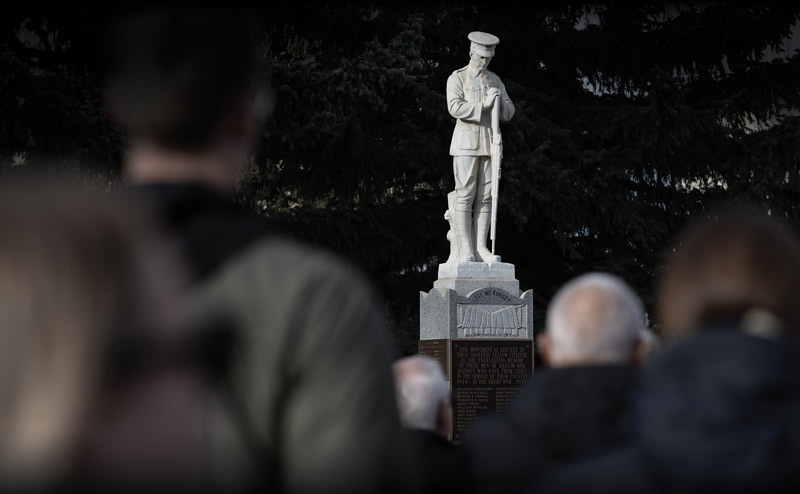
Between 300 and 400 people turned out for the Nov. 11 ceremony in Nanton, Alta.. [Stephen J. Thorne/LM]
A big wind blew across the Alberta prairie almost as soon as Nanton’s Nov. 11 ceremony ended. The dead bomber boys of the Second World War, their 10,673-plus names etched on a black granite memorial, could rest easy. There would be no flying this day.
An ominous cloud bank lingered over the snow-covered Rockies a few dozen kilometres to the west while, in Nanton, all hell broke loose.
Ceremonial flags snapped to attention, then tilted and tipped; wreaths rolled across the lawn fronting the town cenotaph like tumbleweeds and, along Highway 2 stretching 92 kilometres north to Calgary, cars drifted into ditches and road signs snapped off at their bases.
The dust-up didn’t seem to bother many of the 300-400 people who had crowded seven-deep around the angelic white marble soldier standing atop a grey granite base. It bears the names of 25 area men who died in the First World War, seven of whom fought at Vimy Ridge, and 24 more killed in WW II.
After the Remembrance ceremony, many wandered over to the Bomber Command Memorial, walked the length of its wall and surveyed the names. Some ventured into the adjacent Bomber Command Museum of Canada itself. Others lingered at the monument, despite the wind, and pointed out names.
Among them was David, who highlighted the name Harry Llewellyn Davis to his aunt, Colleen Oshanek. David didn’t want his last name used.
A tail gunner aboard the twin-engine Wellington bomber HE 568 of 420 Squadron, RCAF, Warrant Officer 2nd Class Davis was Oshanek’s uncle. A farm boy from Acme, Alta., northeast of Calgary, he was reported missing the day she was born, June 1, 1943. He was 24 years old.
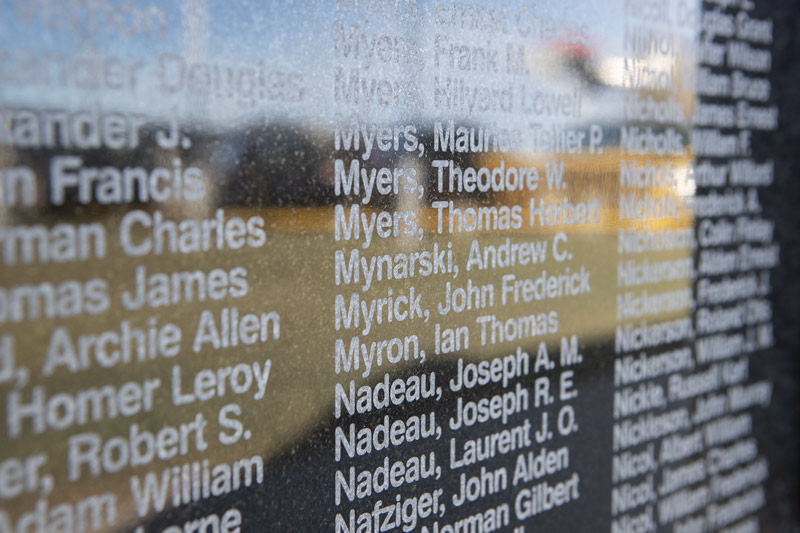
Victoria Cross recipient Andrew Mynarski is among the nearly 10,700 names on Canada’s Bomber Command Memorial. [Stephen J. Thorne/LM]
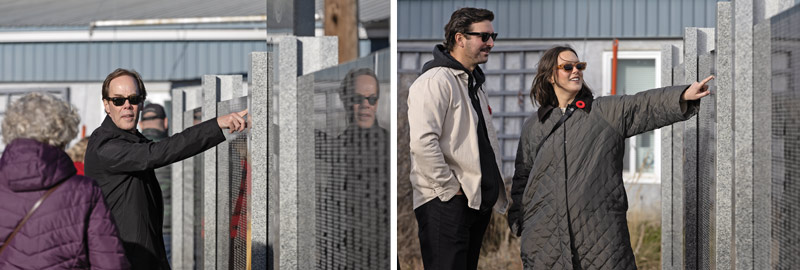
David points out Harry Davis’s name to Colleen Oshanek (below left). Calgarians Sam and Alexandra Dodd (below right) attend the event each year; his grandfather, Flight-Lieutenant Donald Sanders of Salter, Sask., flew Halifax, Wellington and Lancaster bombers.[Stephen J. Thorne/LM]
“I never did know him,” said Oshanek, who heard Davis’s name spoken among family throughout her childhood, but knew almost nothing of his story.
His plane was one of 20 Wellingtons transiting from Royal Air Force Portreath in Cornwall, England, to their new base at Ras El Maa, Morocco, where they were to join the pre-invasion bombing campaign against Sicily, mainland Italy and key Axis-held islands.
The Afrika Korps, along with the Panzer forces previously commanded by the Desert Fox, Generalfeldmarschall Erwin Rommel, had just fallen to Lieutenant-General Bernard Montgomery’s Eighth Army in North Africa. The campaign in Europe was set to begin.
Two of the Wellingtons never made it. They were intercepted over the Bay of Biscay by five Ju 88 heavy fighters out of Lorient, France. Davis’s plane was shot down in flames by the Luftwaffe flight leader, Oberleutnant Hermann Horstmann of 13/KG 40. It was 8:05 a.m.
“I saw the rear gunner bailing out, but his parachute was also burning. No survivors were seen, only wreckage.”
All seven aboard the Wellington were killed, including two ground crew hitching a ride to their new digs. In addition to Davis, they were: the pilot, Flight Sergeant Alexander Theodore Sodero, 21, of Sydney, N.S.; the navigator, Flying Officer George Henry Hubbell, 32, of Arnprior, Ont.; the bomb aimer, Pilot Officer William Robert King, 22, of Kingston, Ont.; the wireless operator/air gunner, Pilot Officer Robert Spencer Hollowell, 24, of Wolseley, Sask.; and the two ground crew, Leading Aircraftman Thomas Robert Brookes, 23, of Montreal and Corporal James Foster MacKenzie, 34, of Red Deer, Alta.
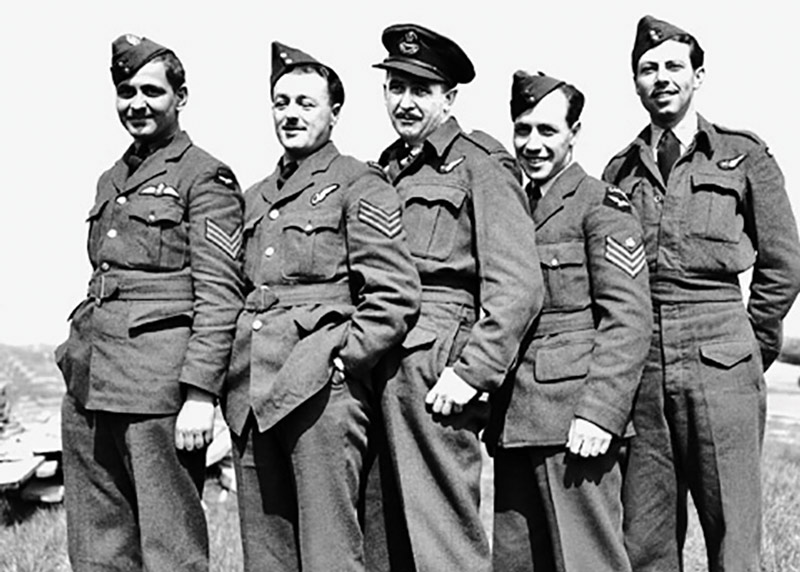
The HE 568 crew (bottom, from left): Sodero, King, Hubbell, Davis and Hollowell.[Bomber Command Museum of Canada]
Minutes later the Germans attacked the second aircraft, Wellington HE 961 piloted by Flying Officer Gordon Saunders McCulloch, 29, of Hamilton. Also aboard were his four aircrew and two ground crewmen.
“I had to break off my first attack because of the enemy plane’s evasive actions and I had got into its rear turret’s field of fire and got a lot of machine gun fire,” reported Horstmann’s rottenflieger (wingman), Unteroffizier Heinz Hommel. “During this first action, my plane was hit by one bullet in the port wing.

There was no shortage of wreaths for the Nanton ceremony.[Stephen J. Thorne/LM]
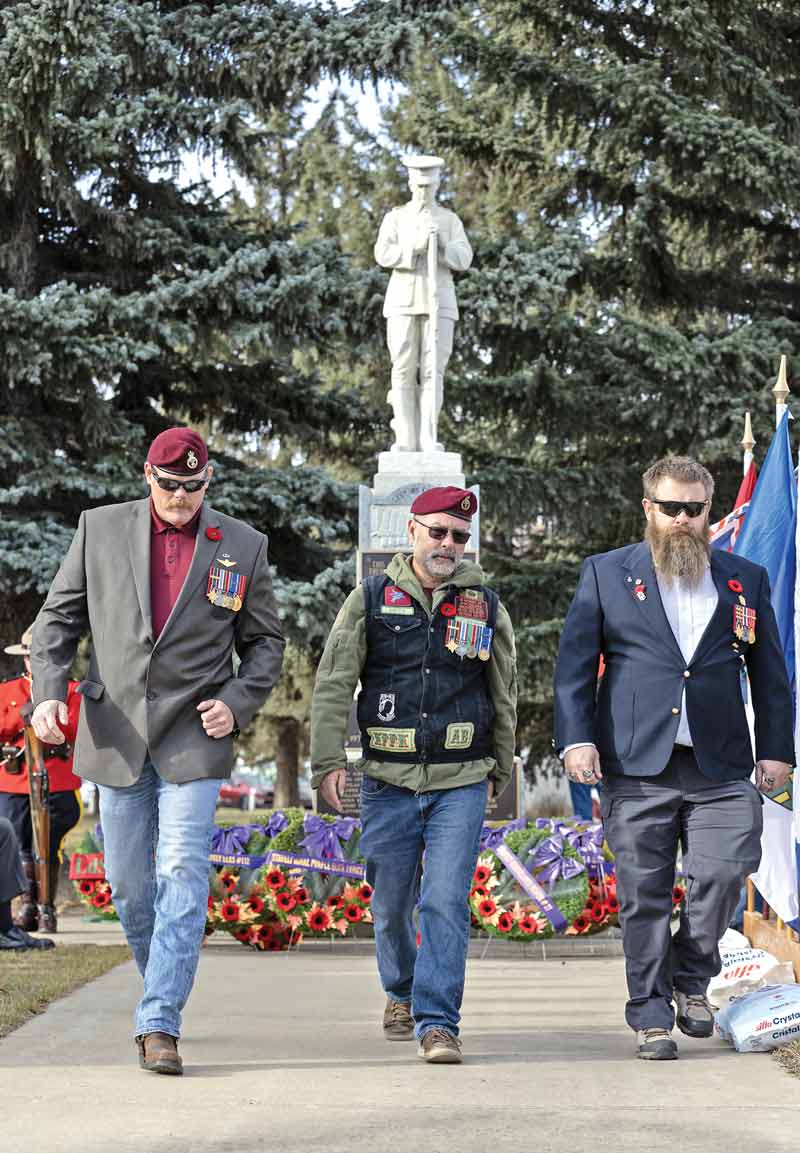
Members of the Canadian chapter of the Nam Knights Motorcycle Club placed a wreath on behalf of Canadians who served with U.S. forces in Vietnam.[Stephen J. Thorne/LM]
“A short time after that, I was able to get into a favourable position and attacked head on from above, watching the cannon and machine gun hits in the enemy plane’s starboard wing,” continued Hommel. “From a distance of 100 metres, I saw a tongue of fire coming out from the starboard wing which became even larger.
“Soon the whole wing was ablaze and then broke off. The plane went into a spin and exploded on hitting the water. I saw the rear gunner bailing out, but his parachute was also burning. No survivors were seen, only wreckage.”
Indeed, the remains of both Canadian crews and their passengers were never recovered. Their names all appear on the memorial outside the museum in Nanton.
They are also listed on the Runnymede Memorial in Surrey, west of London. It includes the names of 20,450 Commonwealth aircrew, 3,050 Canadians, who died with no known grave. Horstmann was killed in action the following December; Hommel was wounded just weeks before the war ended.
Nanton lies at the heart of British Commonwealth Air Training Plan country. The wartime project trained 131,500 aircrew at 107 schools and 184 support units in 231 locations across Canada.
Elementary Flying Training School No. 5 lay 28 kilometres north of Nanton at High River. In Vulcan, 40 kilometres east, was Service Flying Training School No. 19 and, early on, Flying Instructor School No. 2. Service Flying Training School No. 15 was located at Claresholm, 40 kilometres south. They were among a dozen-plus training plan sites in Alberta alone.
Training aircraft in their distinctive “BCATP yellow,” piloted by recruits from Canada, Britain, Australia and New Zealand, were a common sight during the war years, particularly over the Prairies. Nanton was no exception.
In his book, A Thousand Shall Fall, author Murray Peden recalls how he and fellow student Francis Plate would book simultaneous solo sessions and arrange to meet “over some town in the aerobatics area—usually Nanton—where we would proceed to take turns topping the other’s performance.”
The town of about 2,200 is located amid rolling farms and ranchlands. Its Royal Canadian Legion branch is small—just 39 members, including a few Cold War and peacekeeping veterans. They average over 70 years old and buried their last WW II veteran, a sailor, several years ago.
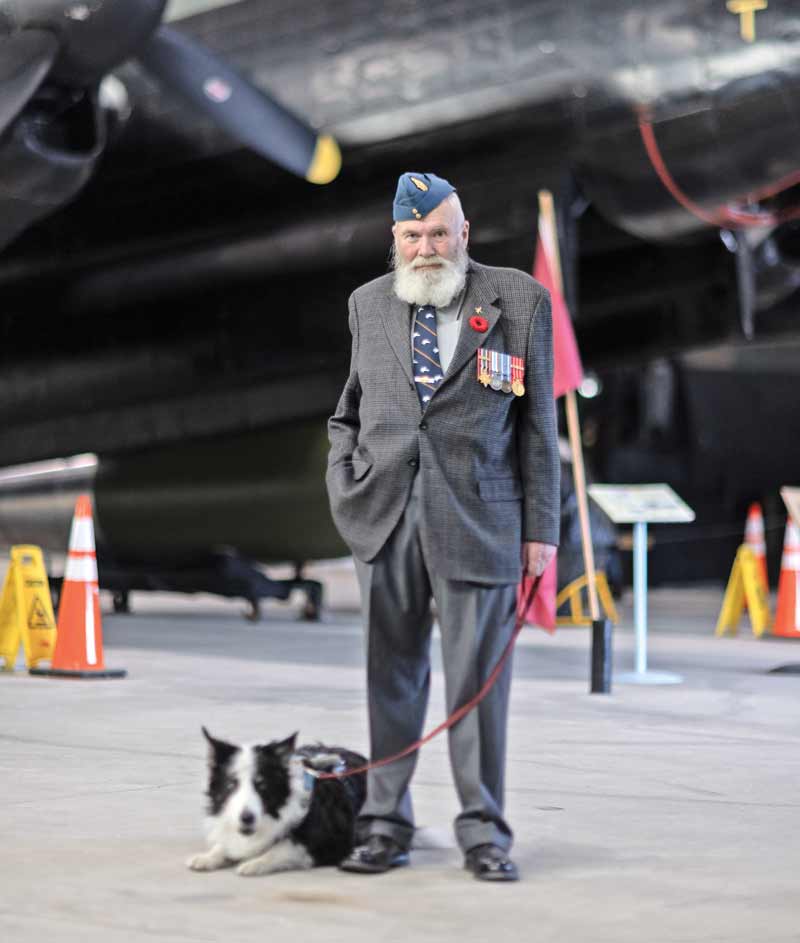
Bruce Beswick flew Buffalos, F-5s and CF-18s during a 25-year career in the Royal Canadian Air Force.[Stephen J. Thorne/LM]
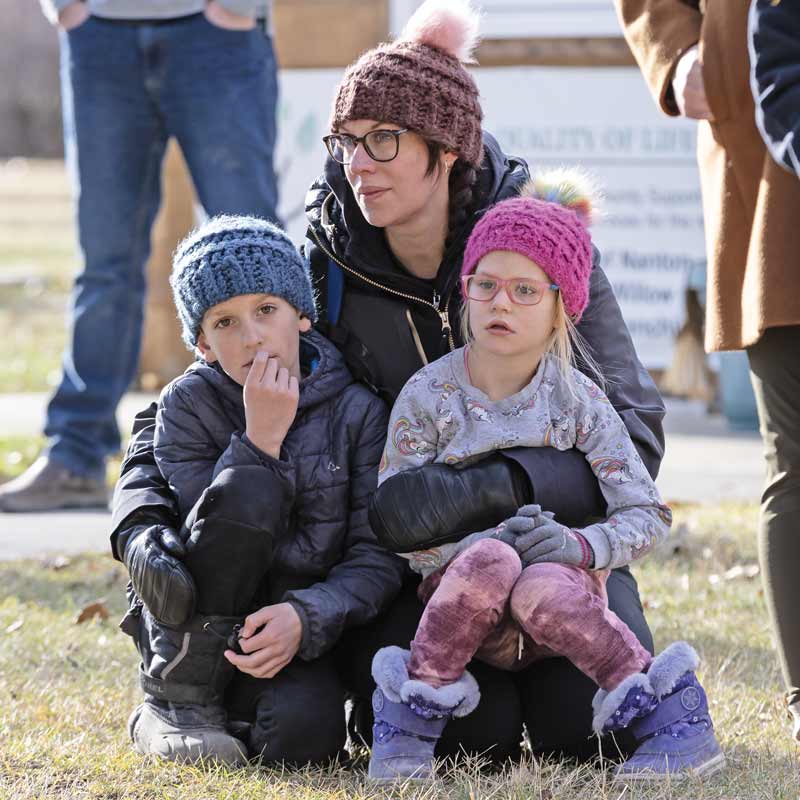
A mom and her children huddle against the prairie wind.[Stephen J. Thorne/LM]
Formed in 1919 when the organization was still known as The Great War Veterans’ Association, the Nanton Legion has never had its own building, and has no facility at all now. It still meets once a month, however, at the Town & Country Kozy Korner, a seniors’ centre next door to the museum.
“Remembrance Day is our claim to fame,” said the branch secretary-treasurer, Marylou Slumskie, the daughter and niece of WW II veterans, who also happens to be the Kozy Korner treasurer. “The town relies on us to plan and organize and do it.
“The Bomber Command Museum has been very gracious and generous, permitting us to form here, meet here, get prepared here prior to going out to the cenotaph.”
“Remembrance Day is our claim to fame,” said the branch secretary-treasurer, Marylou Slumskie, the daughter and niece of WW II veterans.
In fact, Legion members are an integral part of the extensive museum and its activities, running a booth at regular events that feature one of only 17 surviving Avro Lancaster bombers worldwide—two are airworthy; the museum’s Lancaster is not, but its four functioning Rolls-Royce Merlin engines are another rarity.
Unlike either of the flying Lancs, the Nanton version retains its interior configuration to wartime standard, complete with a fully equipped wireless station, single-seat cockpit and other details.
It bears the FM 159 (F2-T) markings of Squadron Leader Ian Bazalgette, a Calgary native who earned a Victoria Cross after he was killed trying to land his crippled aircraft and save two of his wounded crew on Aug. 4, 1944.
Museum curator Karl Kjarsgaard, Slumskie’s husband, called the Nanton Legion the museum’s “right-hand man.”
Branch President Brian Stapley, a retired plumber, gas fitter and steam fitter—and Kozy Korner president—has lived his whole life in Nanton. So did his father Lawrence, a Second World War combat engineer. His mother was a war bride. Both were Legion members.
How do they keep it going?
“By a lick and a prayer,” said Stapley.
In the local cemetery lie 215 veterans. Each year, local Grade 9 students help the Legionnaires place white crosses with poppies beside each marker. The oldest plot among them is the resting place of Hans Henry Anderson, a veteran of the 1898 Spanish-American War. Neither the Americans nor the Last Post Fund would provide him a headstone, so the Legion paid for one from its casino earnings.
The Legion has added RCMP, peacekeeping and Afghanistan plaques to the world wars and Korea plaques that were already on the monument. In 2017, on the 100th anniversary of Canada’s most famous battle, the Nanton Legion unveiled a Vimy commemorative bench near the cenotaph. And nine years ago, it acquired a descendent sapling of the famed Vimy oaks and planted it nearby.
Said Slumskie: “It’s struggling in the Alberta climate, but it’s still hanging in.”
Advertisement





















